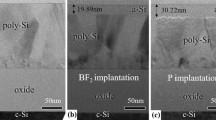Abstract
Over the last couple of years, manufacturers of rapid thermal annealing (RTA) equipment have been aggressively developing lamp-based furnaces capable of achieving ramp-up rates of the order of hundreds of degrees per second. One of the driving forces for such a strategy was the experimental demonstration of 30 nm p-type junctions using a ≈400°C/s ramp-up rate during a spike-anneal (zero soak-time at temperature). It was proposed that the ultra-fast ramp-up was suppressing transient enhanced diffusion (TED) of boron caused by implantation damage. Ultra-fast ramp rate capability was thus embraced as an essential requirement for the next generation of RTA equipment. In this paper, we review more recent experimental data examining the effect of the ramp-up rate during spike- and soak-anneals on enhanced diffusion and ultra-shallow junction formation. The advantage of increasing the ramp-up rate (above ≈50°C/s) is found to be appreciable only during spike-anneals of the shallowest implants. Since TED naturally decreases with decreasing implantation depth, it follows that the observed advantage of a fast ramp-up does not arise from a so-called suppression of TED but from a straightforward reduction of the thermal budget. Since the temperature ramp-down is in practice limited to a rate much smaller than the achievable ramp-up rates (≈75°C/s vs. ≈400°C/s, respectively), a point of diminishing return is quickly reached when attempting to decrease dopant diffusion by increasing the ramp-up rate only. The advantage of a fast ramp-up is similarly mitigated by the finite minimum soak-time achievable in practice, as well as by decreased process control at faster ramp-up rates. While it is apparent that spike-anneals can minimize dopant diffusion while maximizing dopant activation we find that some of the advantages offered by fast ramp-up rates can be duplicated via modification of the implantation parameters. A survey of spike-anneal daa from different sources supports this point.
Similar content being viewed by others
References
National Technology Roadmap for Semiconductors (San Jose, CA: Semiconductor Industry Association, 1997). The 1998 update is available electronically by Internet: http://notes.sematech.org/ntrs/PublNTRS.nsf.
A.T. Fiory, K.K. Bourdelle, A. Agarwal, H.-J. Gossmann, and C.S. Rafferty, Mater. Res. Soc. Symp. Proc. 568 (Warrendale, PA: MRS, 1999).
S. Shishiguchi, A. Mineji, T. Hayashi, and S. Saito, VLSI Tech. Symp. (Piscataway, NJ: IEEE, 1997), p. 1059.
C.S. Rafferty, G.H. Gilmer, M. Jaraiz, D.J. Eaglesham, and H.-J. Gossmann, Appl. Phys. Lett. 68, 2395 (1996).
H.-J. Gossmann, Semiconductor Silicon, ed., H.R. Huff, U. Goselle, and H. Tsuya (Pennington, NJ: Electrochem. Soc., 1998), p. 884.
D.R. Lim, C.S. Rafferty, and F.P. Klemens, Appl. Phys. Lett. 67, 2302 (1995).
A. Agarwal, H.-J. Gossmann, D.J. Eaglesham, L. Pelaz, D.C. Jacobson, D.C. Jacobson, et al., IEDM Tech. Digest 97, 367
A. Agarwal, H.-J. Gossmann, D.J. Eaglesham, L. Pelaz, D.C. Jacobson, T.E. Haynes, and Yu.E. Erokhin, Appl. Phys. Lett. 71, 3141 (1997).
A. Agarwal, A.T. Fiory, H.-J. Gossmann, C.S. Rafferty, P. Frisella, and J. Hebb, Mater. Sci. in Semicond. Proc. 1, 237 (1999).
M.R. Pinto, D.M. Boulin, C.S. Rafferty, R.K. Smith, et al., IEDM Technol. Dig. 92, 923 (1992).
In all simulations of implanted dopant diffusion, the interaction of dopants with damage was included in the form of a “plus” number of interstitials, which form clusters and dissolve (see Ref. 12). No boron-interstitial clusters were included. Boron is active only up to its solid-solubility in silicon.
M.D. Giles, J. Electrochem. Soc. 138, 138 (1991).
R.B. Fair and J.C.C. Tsai, J. Electrochem. Soc. 124, 1107 (1977).
H. Bracht, N.A. Stolwijk, and H. Mehrer, Phys. Rev. B 52, 16542 (1995).
S. Saito, Mater. Res. Soc. Symp. Proc. 532 (Warrendale, PA: MRS, 1999), p. 3.
S. Felch (Paper presented at the Greater Silicon Valley Implant Users Group Meeting, Sunnyvale, February, 1999; D. Downey et al., Solid State Technol. (December 1997).
M. Foad et al., Solid State Technol. (December 1998).
Author information
Authors and Affiliations
Rights and permissions
About this article
Cite this article
Agarwal, A., Gossmann, HJ. & Fiory, A.T. Effect of ramp rates during rapid thermal annealing of ion implanted boron for formation of ultra-shallow junctions. J. Electron. Mater. 28, 1333–1339 (1999). https://doi.org/10.1007/s11664-999-0118-7
Received:
Accepted:
Issue Date:
DOI: https://doi.org/10.1007/s11664-999-0118-7




